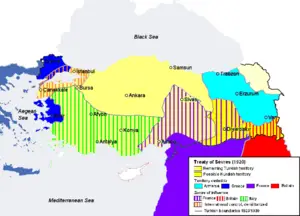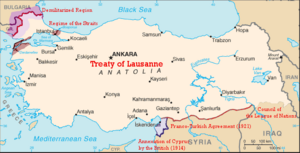Treaty of Lausanne
| Treaty of Lausanne | |
|---|---|
| Signed - location |
1923 July 24 Lausanne, Switzerland |
| Signatories | |
| Depositary | French Republic |
The Treaty of Lausanne (July 24, 1923) was a peace treaty signed in Lausanne, Switzerland, that settled the Anatolian and East Thracian parts of the partitioning of the Ottoman Empire by annulment of the Treaty of Sèvres (1920) that was signed by the Istanbul-based Ottoman government; as the consequence of the Turkish War of Independence between the Allies of World War I and the Ankara-based Grand National Assembly of Turkey (Turkish national movement) led by Mustafa Kemal Atatürk. The treaty also led to the international recognition of the sovereignty of the new Republic of Turkey as the successor state of the defunct Ottoman Empire.[1]
Overview and negotiations

After the expulsion of the Allied forces by the Turkish army under the command of Mustafa Kemal Atatürk, the Ankara-based government of the Turkish national movement rejected the Treaty of Sèvres (1920) that was signed by the Istanbul-based Ottoman government.
Negotiations were undertaken during the Conference of Lausanne at which İsmet İnönü was the chief negotiator for Turkey. Lord Curzon, the British Foreign Secretary of that time, was the chief negotiator of the Allies, while Eleftherios Venizelos negotiated on behalf of Greece. The negotiations took many months. On November 20 1922, the peace conference was opened, and after strenuous debate, was interrupted by Turkish protest on February 4 1923. After reopening again on April 23, and following more protests by the Turks and tense debates, the treaty was signed on July 24 as a result of eight months of arduous negotiation. The delegation on behalf of the Allies included negotiators such as the U.S. Admiral Mark L. Bristol, who served as the United States High Commissioner and championed Turkish efforts.
Treaty stipulations
The treaty was composed of 143 articles with major sections including:[2]
- Convention on the Turkish straits
- Trade (abolition of capitulations)
- Agreements
- Binding letters.
The treaty provided for the independence of the Republic of Turkey but also for the protection of the ethnic Greek minority in Turkey and the mainly ethnically Turkish Muslim minority in Greece. However, most of the Greek population of Turkey and the Turkish population of Greece had already been deported under the earlier Exchange of Populations between Greece and Turkey agreement signed by Greece and Turkey. Only the Greeks of Istanbul, Imbros and Tenedos were excluded (about 270,000 in Istanbul alone at that time),[3] and the Muslim population of Western Thrace (about 86,000[4] in 1922). Article 14 of the treaty granted the islands of Imbros and Tenedos "special administrative organisation", a right that was revoked by the Turkish government on February 17, 1926. The Republic of Turkey also formally accepted the loss of Cyprus (which was "rented" to the British Empire following the Congress of Berlin in 1878, but de jure remained an Ottoman territory until World War I) as well as Egypt and Sudan (which were occupied by British forces with the pretext of "establishing order" in 1882, but de jure remained Ottoman territories until World War I) to the British Empire. The fate of the province of Mosul was left to be determined through the League of Nations. Turkey also renounced all claims on the Dodecanese Islands, which Italy was obliged to return back to Turkey according to the Treaty of Ouchy in 1912 (also known as the First Treaty of Lausanne (1912), as it was signed at the Ouchy Castle in Lausanne, Switzerland) following the Italo-Turkish War (1911-1912).[5]
Borders
The treaty delimited the boundaries of Greece, Bulgaria, and Turkey; formally ceded all Turkish claims on the Dodecanese Islands (Article 15); Cyprus (Article 20); Egypt and Sudan (Article 17); Iraq and Syria (Article 3); and (along with the Treaty of Ankara) settled the boundaries of the latter two nations.[6] Turkey also renounced its priviliges in Libya which were defined by Article 10 of the Treaty of Ouchy in 1912 (per Article 22 of the Treaty of Lausanne in 1923).[7]
Agreements
Among many agreements, there was a separate agreement with the United States: the Chester concession. The U.S. Senate refused to ratify the treaty and consequently Turkey annulled the concession.[2]
Aftermath
- The Treaty of Lausanne led to the international recognition of the sovereignty of the new Republic of Turkey as the successor state of the defunct Ottoman Empire.[8]
- The Convention on the Turkish Straits lasted only thirteen years and was replaced with the Montreux Convention Regarding the Regime of the Turkish Straits in 1936. The customs limitations in the treaty were shortly reworked.
- Hatay Province remained a part of the French Mandate of Syria according to the Treaty of Lausanne, but in 1938 gained its independence as the Hatay State, which later joined Turkey with a referendum in 1939. For many decades Syria didn't recognize the addition of Hatay Province to Turkey and continued to show it as a part of Syria on its maps.
- Political amnesty was applied. 150 personae non gratae of Turkey (descendants of the Ottoman dynasty) slowly acquired citizenship - the last one was in 1974.
See also
- Aftermath of World War I
- Turks of Western Thrace
- Greeks of Turkey
- Greek refugees
- Minority Treaties
- Ismet Inönü
ReferencesISBN links support NWE through referral fees
- ↑ Full text of the Treaty of Lausanne (1923)
- ↑ 2.0 2.1 Mango, Andrew (2002). Ataturk: The Biography of the Founder of Modern Turkey. Overlook Press, 388. ISBN 158567334X.
- ↑ The Greek minority of Turkey
- ↑ ΜΟΥΣΟΥΛΜΑΝΙΚΗ ΜΕΙΟΝΟΤΗΤΑ ΘΡΑΚΗΣ
- ↑ Treaty of Ouchy (1912), also known as the First Treaty of Lausanne
- ↑ Full text of the Treaty of Lausanne (1923)
- ↑ Full text of the Treaty of Lausanne (1923)
- ↑ Full text of the Treaty of Lausanne (1923)
External links
- Full text of the Treaty of Lausanne (1923)
- Treaty of Ouchy (1912), also known as the First Treaty of Lausanne
|
Template:Turkish War of Independence
| |||||||||||||||||||||
bg:Лозански договор ca:Tractat de Lausana da:Lausanne-traktaten de:Vertrag von Lausanne el:Συνθήκη της Λωζάνης es:Tratado de Lausana eo:Traktato de Lausanne fr:Traité de Lausanne (1923) ko:로잔 조약 it:Trattato di Losanna he:הסכם לוזאן ku:Peymana Lozanê lv:Lozannas miera līgums lt:Lozanos tarptautinė konferencija hu:Lausanne-i békeszerződés nl:Vrede van Lausanne ja:ローザンヌ条約 pl:Traktat w Lozannie pt:Tratado de Lausanne ru:Лозаннская конференция sr:Лозански мир 1923. fi:Lausannen sopimus sv:Lausannefreden tr:Lozan Antlaşması ur:معاہدہ لوزان zh:洛桑条约
Credits
New World Encyclopedia writers and editors rewrote and completed the Wikipedia article in accordance with New World Encyclopedia standards. This article abides by terms of the Creative Commons CC-by-sa 3.0 License (CC-by-sa), which may be used and disseminated with proper attribution. Credit is due under the terms of this license that can reference both the New World Encyclopedia contributors and the selfless volunteer contributors of the Wikimedia Foundation. To cite this article click here for a list of acceptable citing formats.The history of earlier contributions by wikipedians is accessible to researchers here:
The history of this article since it was imported to New World Encyclopedia:
Note: Some restrictions may apply to use of individual images which are separately licensed.

